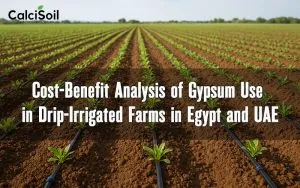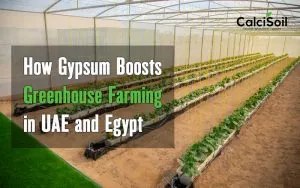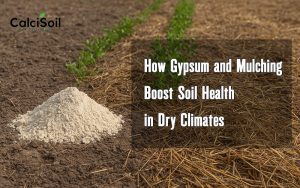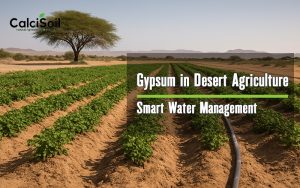
The Role of Gypsum in Agriculture: Benefits, Risks, and Gypsum Toxicity
Gypsum offers several benefits in agriculture. It helps to reduce aluminum toxicity in soil, particularly in subsoils, and is a source of calcium and sulfur for plant nutrition. Gypsum also aids in reducing runoff and erosion, making it a best management practice for decreasing soluble phosphorus losses. Additionally, it improves water-use efficiency, soil structure, and aeration, and enhances the values of liming. Gypsum has been used in agriculture for over 250 years and is considered a proven resource to add nutrients and improve soil structure, making it a diverse and valuable tool for farmers.
Although it has many benefits for agriculture, excessive use of these substances may be harmful to agriculture. In this article, we are going to examine the side effects of its excessive use in the fields.
Can gypsum be harmful for agriculture?
Gypsum can have both beneficial and potentially harmful effects in agriculture. It is high in calcium and sulfur, which can improve soil structure, promote better root development of crops, and make certain nutrients more available to plants, especially in acid soils. Gypsum can also counteract the toxic effect of soluble aluminum on root development.
However, it is important to use gypsum appropriately, as excessive application can lead to the removal of essential nutrients such as iron, aluminum, and manganese from the soil, potentially harming plant growth. Additionally, if the source of gypsum is FGD gypsum, application at a rate greater than predicted necessary may be interpreted as disposal and could be harmful. Therefore, while gypsum can be beneficial for agriculture, it should be used conservatively and based on soil analysis to avoid potential negative impacts.
Risk of using gypsum
The use of gypsum in agriculture presents both benefits and risks. The risks of using gypsum as a soil amendment are relatively low but Some of the risks associated with gypsum use in agriculture include:
Sulfur and Phosphorus Effects: Gypsum can increase the sulfur and phosphorus content in the soil, which may lead to potential environmental risks such as phosphorus runoff and increased sulfur levels in manure, leading to dangerous hydrogen sulfide gas emissions.
Soluble P Loss: Gypsum can curb the risk of soluble phosphorus loss, which is an environmental concern in agricultural regions. However, it’s important to assess the overall impact of increased phosphorus levels in the soil.
Sulfate and Calcium Concentrations: Gypsum is relatively soluble, and the gradual flushing away of sulfate and calcium from the soil via surface runoff and drainage flow can increase their concentrations in downstream waters, potentially posing ecological risks to freshwater biota.
Soil Toxicity: While gypsum can reduce soil toxicity levels, particularly aluminum toxicity, it’s essential to ensure that it is used appropriately to avoid potential negative impacts on both agricultural and environmental aspects.
It’s important for farmers to use gypsum in accordance with best management practices and to consider the potential environmental implications of its use, such as its impact on soil and water quality, before widespread application.
Gypsum toxicity effects on growing plants
The toxicity effects of gypsum on growing plants can vary depending on the concentration of gypsum in the soil. Research indicates that high levels of gypsum can be toxic to plant growth. For example, a study reported that 30 percent gypsum content in soils of Tunisia is toxic to plant growth, and plant growth is reduced when the gypsum content exceeds 20 to 25 percent.
Avoiding gypsum toxicity in soil
To avoid gypsum toxicity in soil, it’s important to use it appropriately and consider the soil’s specific needs. Here are some ways to avoid gypsum toxicity:
Understand the Soil’s Needs: Gypsum can be beneficial for improving water and root infiltration in sodic soils, as well as treating aluminum toxicity in soils with a pH lower than 4.5.
Consider Soil Type and Management Practices: Research is needed to determine the best soil types and management practices for gypsum use. It’s important to compare the cost of gypsum with other alternative products and consider situational uses, such as addressing the need for sulfur or calcium in specific crops and treating aluminum toxicity in acidic subsoils.
Follow Application Guidelines: When applying gypsum, it’s essential to follow specific guidelines, such as the amount of gypsum required per meq of sodium, and to ensure sufficient quality water is added to leach the displaced sodium beyond the root zone.
Be Mindful of Soil Characteristics: Gypsum is more soluble and mobile in a shorter time frame, making it suitable for neutralizing acid subsoils and leaching into the subsoil. It’s important to consider the soil’s pH, aluminum levels, and the presence of free lime when deciding whether to use gypsum or other soil amendments.
By understanding the specific needs of the soil, considering the soil type and management practices, following application guidelines, and being mindful of soil characteristics, it’s possible to avoid gypsum toxicity and effectively utilize it as a soil amendment.







